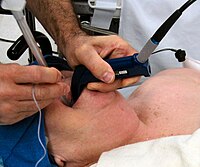
Apneic oxygenation reduces the incidence of hypoxemia during emergency intubation: A systematic review and meta‐analysis
Sign Up to like & getrecommendations! Published in 2017 at "American Journal of Emergency Medicine"
DOI: 10.1016/j.ajem.2017.06.029
Abstract: Study objective Apneic oxygenation has been advocated for the prevention of hypoxemia during emergency endotracheal intubation. Because of conflicting results from recent trials, the efficacy of apneic oxygenation remains unclear. We performed a systematic review… read more here.
Keywords: oxygenation; hypoxemia emergency; apneic oxygenation; meta analysis ... See more keywords

1267: EVALUATING THE SAFETY OF APNEIC OXYGENATION IN THE PEDIATRIC CARDIOVASCULAR INTENSIVE CARE UNIT
Sign Up to like & getrecommendations! Published in 2020 at "Critical Care Medicine"
DOI: 10.1097/01.ccm.0000644984.95457.13
Abstract: Introduction/Hypothesis: Tracheal intubation (TI) is a high risk procedure for the pediatric population in the cardiovascular intensive care unit (CVICU). There is currently limited data on apneic oxygenation (AO) feasibility and effectiveness among children in… read more here.
Keywords: care; apneic oxygenation; post; intensive care ... See more keywords

Apneic oxygenation in pediatric anesthesia
Sign Up to like & getrecommendations! Published in 2022 at "Current Opinion in Anaesthesiology"
DOI: 10.1097/aco.0000000000001127
Abstract: Purpose of review Apneic oxygenation is increasingly used in pediatric anesthesia. Its benefit for specific applications depends on the effect of apneic oxygenation on safe apnea time and carbon dioxide (CO2) elimination, on differences between… read more here.
Keywords: high flow; pediatric anesthesia; oxygenation; apneic oxygenation ... See more keywords

Efficacy of Apneic Oxygenation During Pediatric Endotracheal Intubation
Sign Up to like & getrecommendations! Published in 2021 at "Pediatric Emergency Care"
DOI: 10.1097/pec.0000000000002539
Abstract: Objective Because of the abundance of complications associated with peri-intubation hypoxia, maintaining adequate oxygen saturation during endotracheal intubation (ETI) is of great concern. In addition to standard preoxygenation techniques, apneic oxygenation (AO), the continuous flow… read more here.
Keywords: endotracheal intubation; apneic oxygenation; efficacy; oxygenation pediatric ... See more keywords

Emergency Department use of Apneic Oxygenation Versus Usual Care During Rapid Sequence Intubation: A Randomized Controlled Trial (The ENDAO Trial)
Sign Up to like & getrecommendations! Published in 2017 at "Academic Emergency Medicine"
DOI: 10.1111/acem.13274
Abstract: OBJECTIVES Desaturation leading to hypoxemia may occur during rapid sequence intubation (RSI). Apneic oxygenation (AO) was developed to prevent the occurrence of oxygen desaturation during the apnea period. The purpose of this study was to… read more here.
Keywords: trial; rapid sequence; intubation; apneic oxygenation ... See more keywords

Apneic oxygenation via nasal cannula for intubation of a premature neonate with multiple airway anomalies
Sign Up to like & getrecommendations! Published in 2019 at "BMJ Case Reports"
DOI: 10.1136/bcr-2018-227494
Abstract: Intubating a neonate under non-emergent conditions may be quite stressful, even for experienced providers, due to the potential for rapid oxygen desaturation. Pulmonary physiology and increased metabolic oxygen demand in this patient population contribute to… read more here.
Keywords: apneic oxygenation; intubation; oxygenation via; nasal cannula ... See more keywords

Limitations of transcutaneous carbon dioxide monitoring in apneic oxygenation
Sign Up to like & getrecommendations! Published in 2023 at "PLOS ONE"
DOI: 10.1371/journal.pone.0286038
Abstract: Background High-flow nasal oxygenation is increasingly used during sedation procedures and general anesthesia in apneic patients. Transcutaneous CO2 (ptcCO2)-monitoring is used to monitor hypercapnia. This study investigated ptcCO2-monitoring during apneic oxygenation. Methods We included 100… read more here.
Keywords: oxygenation; monitoring apneic; monitoring; min ... See more keywords